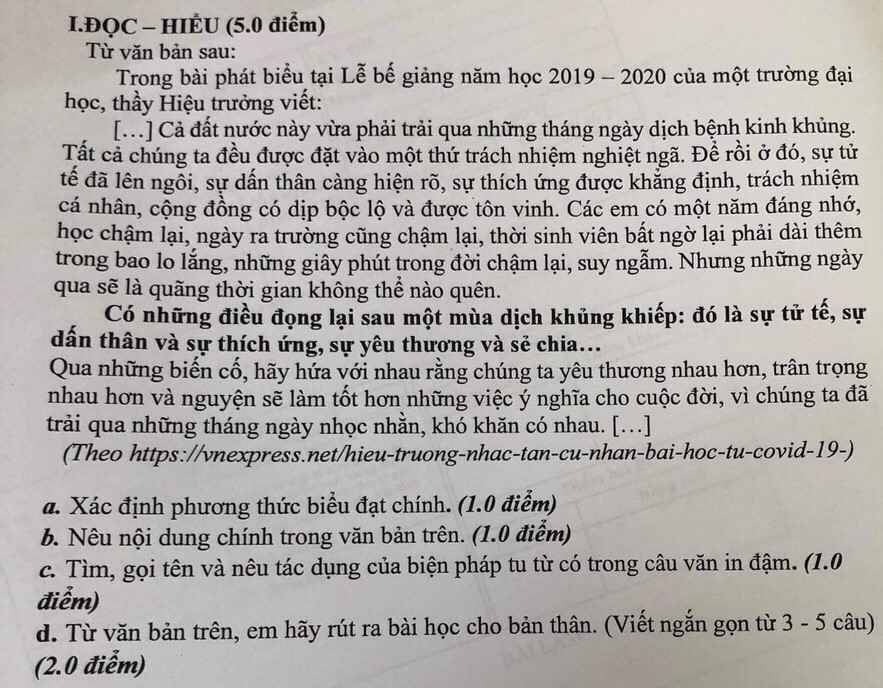\(\sqrt{20}-\sqrt{21-4\sqrt{5}}\)
Hãy nhập câu hỏi của bạn vào đây, nếu là tài khoản VIP, bạn sẽ được ưu tiên trả lời.


a) Đặt \(\left\{{}\begin{matrix}u=\dfrac{1}{x+y}\\v=\dfrac{1}{x-y}\end{matrix}\right.\left(1\right)\)
hệ phương trình trở thành \(\left\{{}\begin{matrix}2u+v=\dfrac{5}{3}\\6u-2v=1\end{matrix}\right.\)
Đây là hệ hai phương trình bậc nhất 2 ẩn, dùng phép cộng đại số để giải.
Sau khi giải ra u, v thế vào (1) để tìm \(x,y\).
b) Xét 2 trường hợp:
+) \(y\ge2\Rightarrow\left|y-2\right|=y-2\).
Phương trình đầu tiên trở thành \(3x-y+2=3\)
Đến đây bạn giải hệ hai phương trình bậc nhất hai ẩn nhé.
+) Tương tự, \(y\lt2\Rightarrow\left|y-2\right|=2-y\)
*Chú ý: tại mỗi trường hợp, đối chiếu nghiệm với điều kiện của y.

A B C O H D E
a/
Xét tg vuông BHD và tg vuông OBD có
\(\widehat{ODB}\) chung
=> tg BHD đồng dạng với tg OBD
\(\Rightarrow\dfrac{BD}{DO}=\dfrac{DH}{BD}\Rightarrow BD^2=DH.DO\) (đpcm)
b/
Xét tg AEB có
\(\widehat{AEB}=90^o\) (góc nội tiếp chắn nửa đường tròn) (đpcm)
Ta có \(BD^2=HD.DO\) (cmt) (1)
Xét tg vuông BED và tg vuông ABD có
\(\widehat{ADB}\) chung
=> tg BED đồng dạng với tg ABD
\(\Rightarrow\dfrac{BD}{DA}=\dfrac{DE}{BD}\Rightarrow BD^2=DE.DA\) (2)
Từ (1) và (2) => HD.DO = DE.DA (đpcm)
c/
Xét tg DBC có
DB=DC (Hai tiếp tuyến cùng xp từ 1 điểm ngoài đường tròn)
=> tg DBC cân tại D
Ta có \(DH\perp BC\)
=> \(\widehat{ODC}=\widehat{ODB}\) (trong tg cân đường cao xuất phát từ đỉnh đồng thời là đường phân giác)
Xét tg OCD và tg OBD có
DC=DB (cmt)
OD chung
\(\widehat{ODC}=\widehat{ODB}\) (cmt)
=> tg OCD = tg OBD (c.g.c)
\(\Rightarrow\widehat{OCD}=\widehat{OBD}=90^o\) => DC là tiếp tuyến của (O) (đpcm)
ta có
\(sđ\widehat{DCE}=\dfrac{1}{2}sđ\) cung CE (góc nt đường tròn)
\(sđ\widehat{CAD}=\dfrac{1}{2}sđ\) cung CE (góc nt đường tròn)
\(\Rightarrow\widehat{DCE}=\widehat{CAD}\) (1)
Xét tg ECD có \(\widehat{DEC}=180^o-\widehat{DCE}-\widehat{ADC}\) (2)
Xét tg DAC có \(\widehat{DCA}=180^o-\widehat{CAD}-\widehat{ADC}\) (3)
Từ (1) (2) (3) \(\Rightarrow\widehat{DEC}=\widehat{DCA}\) (đpcm)


1. In the 20th century.
2. It was a major means of transport for Hanoians.
3. In 1990.
4. The population has increased dramatically.
5. New rail systems including a skytrain and a subway are under way.
6. I think the old train is more impressive to Hanoians because the train in Hanoi and its clanging sound have gone deep into Hanoians’ mind and heart.

Đặt \(\left\{{}\begin{matrix}a=3x^2-4x+1\\b=3x^2+2x+1\end{matrix}\right.\left(a,b\ne0\right)\Rightarrow x=\dfrac{a-b}{6}\).
Phương trình đã cho trở thành
\(\dfrac{2}{a}+\dfrac{13}{b}=\dfrac{36}{a-b}\\ \overset{\text{nhân chéo và rút gọn}}{\Rightarrow}2b^2-25ab-13a^2=0\\\Leftrightarrow\left(b-13a\right) \left(2b+a\right)=0\\ \Leftrightarrow\left\{{}\begin{matrix}b=13a\\a=-2b\end{matrix}\right..\)
Đến đây bạn thay ngược $x$ trở lại và giải tiếp nhé.

Bạn nhân chéo rồi rút gọn thì được:
\(x^4-3x^3+3x+1=0\\ \Leftrightarrow(x^2-2x-1)(x^2-x-1)=0\)
Bạn tự giải tiếp nhé.

Lời giải:
$\sqrt{20}-\sqrt{21-4\sqrt{5}}=\sqrt{20}-\sqrt{20+1-2\sqrt{20}}=\sqrt{20}-\sqrt{(\sqrt{20}-1)^2}=\sqrt{20}-|\sqrt{20}-1|=\sqrt{20}-(\sqrt{20}-1)=1$